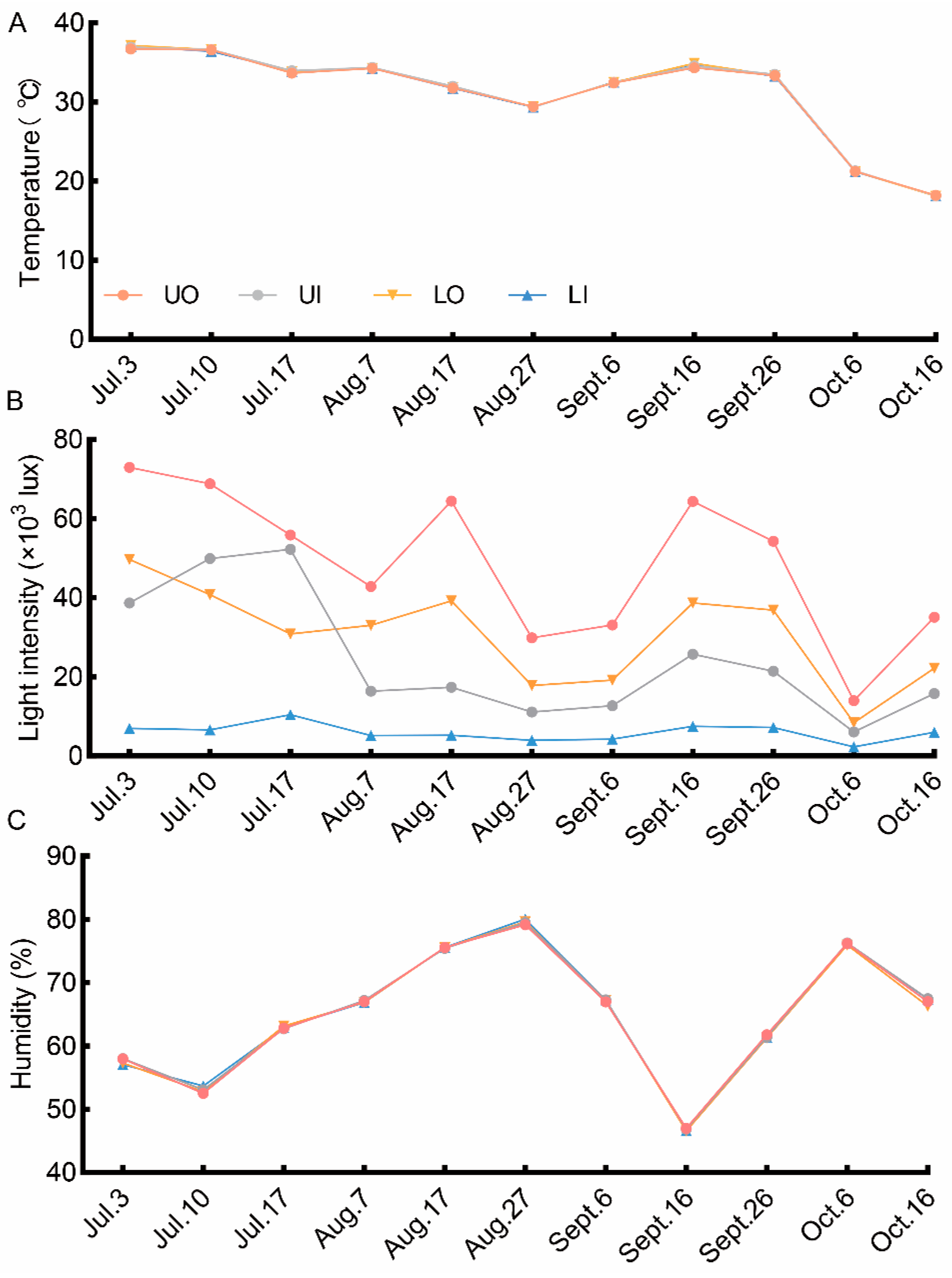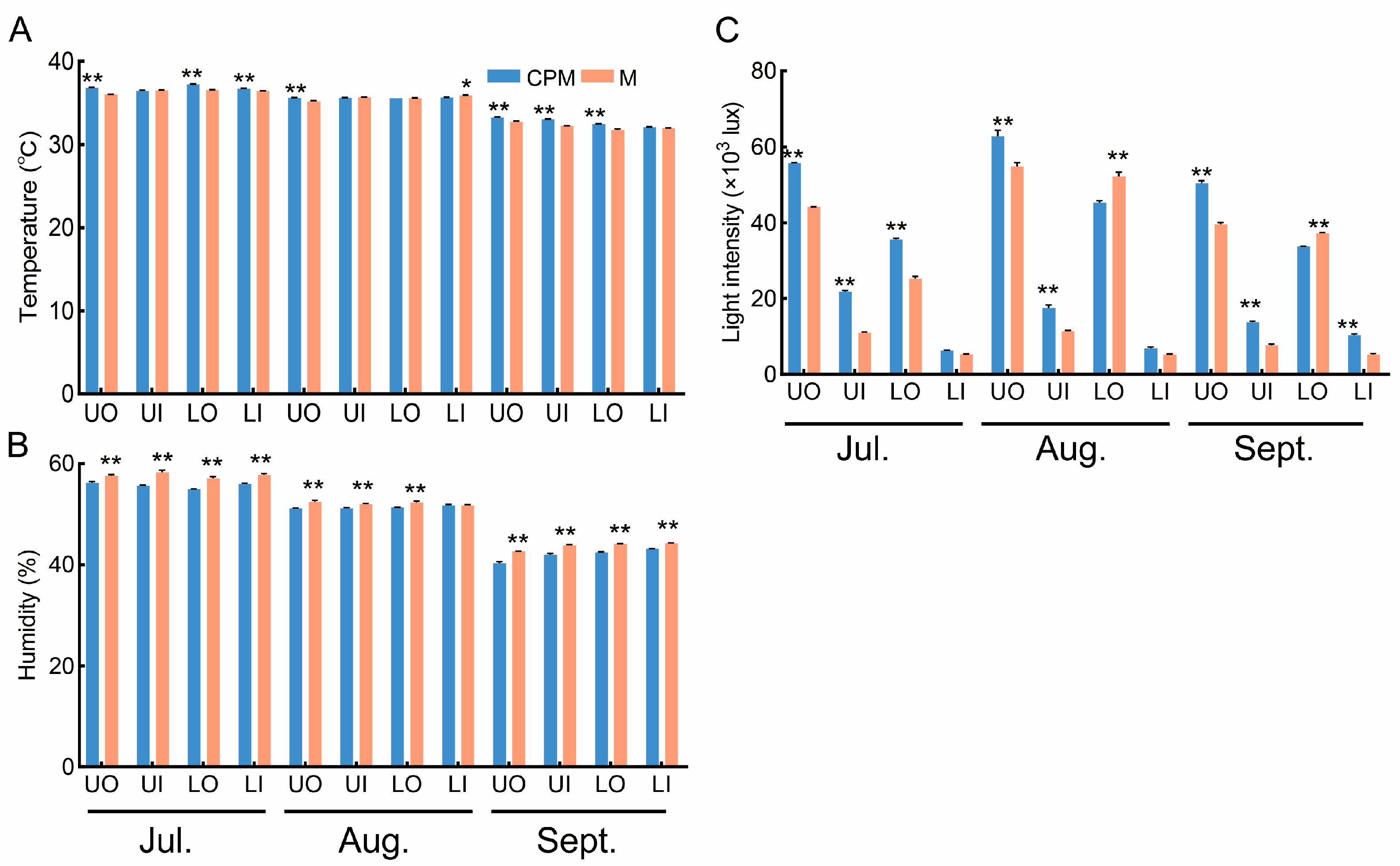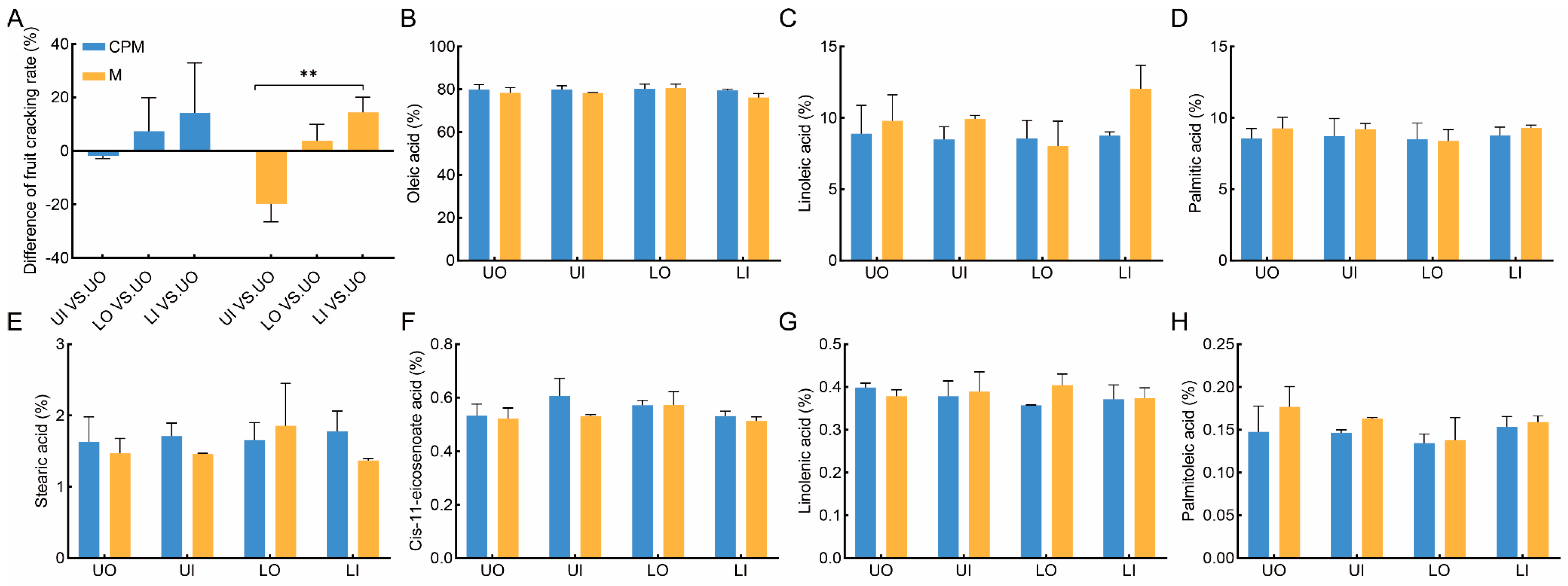The Combination of High-Light Efficiency Pruning and Mulching Improves Fruit Quality and Uneven Maturation at Harvest in Camellia oleifera
Abstract
:1. Introduction
2. Materials and Methods
2.1. Experimental Area and Plant Materials
2.2. Canopy Division and Tree Canopy Environmental Characteristics
2.3. The Combination of High-Light Efficiency Pruning and Mulching of C. oleifera Trees
2.4. Fruit Sampling, Fruit Morphology, and Physiological Determination
2.5. Statistical Analysis
3. Results
3.1. Variation in the Microclimate within the Canopy during the Growing Season
3.2. Characteristics of Fruit Development at Different Canopy Positions
3.3. Response of the C. oleifera Canopy Microclimate to CPM
3.4. CPM Promoted Fruit Cracking and Ripening in C. oleifera Trees
3.5. Response of Yield and Quality to C. oleifera Tree Pruning
4. Discussion
4.1. Variation in the Canopy Microclimate throughout the Fruit Growing Season
4.2. The Impact of Canopy Position on the Fruit Development Characteristics
4.3. High-Light Efficiency Pruning Regulated the Canopy Microclimate
4.4. High-Light Efficiency Pruning of C. oleifera Trees Improved Fruit Quality and Maturity Uniformity at Harvest
5. Conclusions
Supplementary Materials
Author Contributions
Funding
Data Availability Statement
Acknowledgments
Conflicts of Interest
References
- Zhu, G.; Liu, H.; Xie, Y.; Liao, Q.; Lin, Y.; Liu, Y.; Liu, Y.; Xiao, H.; Gao, Z.; Hu, S. Postharvest processing and storage methods for Camellia oleifera seeds. Food Rev. Int. 2019, 36, 319–339. [Google Scholar] [CrossRef]
- Cheng, X.X.; Yang, T.; Wang, Y.H.; Zhou, B.Q.; Yan, L.; Teng, L.Z.; Wang, F.B.; Chen, L.L.; He, Y.; Guo, K.P.; et al. New method for effective identification of adulterated Camellia oil basing on Camellia oleifera-specific DNA. Arab. J. Chem. 2018, 11, 815–826. [Google Scholar] [CrossRef]
- Luan, F.; Zeng, J.; Yang, Y.; He, X.; Wang, B.; Gao, Y.; Zeng, N. Recent advances in Camellia oleifera Abel: A review of nutritional constituents, biofunctional properties, and potential industrial applications. J. Funct. Foods 2020, 75, 104242. [Google Scholar] [CrossRef]
- Ma, J.L.; Ye, H.; Rui, Y.K.; Chen, G.C.; Zhang, N.Y. Fatty acid composition of Camellia oleifera oil. J. Für Verbraucherschutz Und Leb. 2010, 6, 9–12. [Google Scholar] [CrossRef]
- Zhou, D.Y.; Liu, Y.X.; Xu, Z.L.; Yin, F.W.; Song, L.; Wan, X.L.; Song, Y.K.; Zhu, B.W. Effects of long-term intake of Antarctic krill oils on artery blood pressure in spontaneously hypertensive rats. J. Sci. Food Agric. 2017, 97, 1143–1148. [Google Scholar] [CrossRef] [PubMed]
- Zhang, Z.K.; Hu, M.J.; Yun, Z.; Wang, J.B.; Feng, G.; Gao, Z.Y.; Shi, X.Q.; Jiang, Y.M. Effect of tea seed oil treatment on browning of litchi fruit in relation to energy status and metabolism. Postharvest Biol. Technol. 2017, 132, 97–104. [Google Scholar] [CrossRef]
- Chou, T.Y.; Lu, Y.F.; Inbaraj, B.S.; Chen, B.H. Camelia oil and soybean-camelia oil blend enhance antioxidant activity and cardiovascular protection in hamsters. Nutrition 2018, 51–52, 86–94. [Google Scholar] [CrossRef] [PubMed]
- Guo, L.; Guo, Y.; Wu, P.; Lu, F.; Zhu, J.; Ma, H.; Chen, Y.; Zhang, T. Camellia oil lowering blood pressure in spontaneously hypertension rats. J. Funct. Foods 2020, 70, 103915. [Google Scholar] [CrossRef]
- Cao, Y.Q.; Yao, X.H.; Ren, H.D.; Wang, K.L. Changes in contents of endogenous hormones and main mineral elements in oil-tea camellia fruit during maturation. J. Beijing For. Univ. 2015, 37, 76–81. [Google Scholar] [CrossRef]
- Song, Q.; Ji, K.; Mo, W.; Wang, L.; Chen, L.; Gao, L.; Gong, W.; Yuan, D. Dynamics of sugars, endogenous hormones, and oil content during the development of Camellia oleifera fruit. Botany 2021, 99, 515–529. [Google Scholar] [CrossRef]
- Zhang, F.; Li, Z.; Zhou, J.; Gu, Y.; Tan, X. Comparative study on fruit development and oil synthesis in two cultivars of Camellia oleifera. BMC Plant Biol. 2021, 21, 348. [Google Scholar] [CrossRef] [PubMed]
- Yuan, C.P.; Lei, T.W.; Mao, L.L.; Liu, H.; Wu, Y. Soil surface evaporation processes under mulches of different sized gravel. Catena 2009, 78, 117–121. [Google Scholar] [CrossRef]
- Xie, Z.K.; Wang, Y.J.; Jiang, W.L.; Wei, X.H. Evaporation and evapotranspiration in a watermelon field mulched with gravel of different sizes in northwest China. Agric. Water Manag. 2006, 81, 173–184. [Google Scholar] [CrossRef]
- Ye, H.L.; Chen, Z.G.; Jia, T.T.; Su, Q.W.; Su, S.C. Response of different organic mulch treatments on yield and quality of Camellia oleifera. Agric. Water Manag. 2021, 245, 106654. [Google Scholar] [CrossRef]
- Bai, H.S.; Blumfield, T.J.; Reverchon, F. The impact of mulch type on soil organic carbon and nitrogen pools in a sloping site. Biol. Fertil. Soils 2013, 50, 37–44. [Google Scholar] [CrossRef]
- Luo, J.; Xu, M.; Liu, C.; Wei, S.; Tang, H. Effects comparation of different mulching methods on soil in pitaya orchards. Int. Agrophysics 2021, 35, 267–276. [Google Scholar] [CrossRef]
- Waheed, A.; Li, C.; Muhammad, M.; Ahmad, M.; Khan, K.A.; Ghramh, H.A.; Wang, Z.; Zhang, D. Sustainable potato growth under straw mulching practices. Sustainability 2023, 15, 442. [Google Scholar] [CrossRef]
- Zhao, H.; Wang, R.Y.; Ma, B.L.; Xiong, Y.C.; Qiang, S.C.; Wang, C.L.; Liu, C.A.; Li, F.M. Ridge-furrow with full plastic film mulching improves water use efficiency and tuber yields of potato in a semiarid rainfed ecosystem. Field Crops Res. 2014, 161, 137–148. [Google Scholar] [CrossRef]
- Li, X.B. The Effect of Mulching on Soil Temperature, Winter potato (Solanum Tuberosum L.) growth and yield in field experiment, South China. Appl. Ecol. Environ. Res. 2018, 16, 913–929. [Google Scholar] [CrossRef]
- Goel, L.; Shenker, V.; Sharma, R.K. Effect of organic mulches on agronomic parameters—A case study of tomato crop (Mill.). Int. J. Recycl. Org. 2020, 9, 297–307. [Google Scholar] [CrossRef]
- López-Urrea, R.; Sánchez, J.M.; Montoro, A.; Mañas, F.; Intrigliolo, D.S. Effect of using pruning waste as an organic mulching on a drip-irrigated vineyard evapotranspiration under a semi-arid climate. Agric. For. Meteorol. 2020, 291, 108064. [Google Scholar] [CrossRef]
- Chan, K.Y.; Fahey, D.J.; Newell, M.; Barchia, I. Using composted mulch in vineyards—Effects on grape yield and quality. Int. J. Fruit Sci. 2010, 10, 441–453. [Google Scholar] [CrossRef]
- Chen, H.X.; Liu, J.J.; Zhang, A.F.; Chen, J.; Cheng, G.; Sun, B.H.; Pi, X.M.; Dyck, M.; Si, B.C.; Zhao, Y.; et al. Effects of straw and plastic film mulching on greenhouse gas emissions in Loess Plateau, China: A field study of 2 consecutive wheat-maize rotation cycles. Sci. Total Environ. 2017, 579, 814–824. [Google Scholar] [CrossRef] [PubMed]
- Kader, M.A.; Nakamura, K.; Senge, M.; Mojid, M.A.; Kawashima, S. Soil hydro-thermal regimes and water use efficiency of rain-fed soybean (Glycine max) as affected by organic mulches. Agric. Water Manag. 2019, 223, 105707. [Google Scholar] [CrossRef]
- Adiga, D.J.; Veena, G.L.; Thondaiman, V.; Babli, M. An overview of canopy management in cashew (Anacardium occidentale L.). J. Hortic. Sci.-India 2020, 15, 127–135. [Google Scholar] [CrossRef]
- Hipps, N.A.; Davies, M.J.; Dunn, J.M.; Griffiths, H.; Atkinson, C.J. Effects of two contrasting canopy manipulations on growth and water use of London plane (Platanus × acerifolia) trees. Plant Soil 2014, 382, 61–74. [Google Scholar] [CrossRef]
- Rutter, N.; Essery, R.; Baxter, R.; Hancock, S.; Horton, M.; Huntley, B.; Reid, T.; Woodward, J. Canopy structure and air temperature inversions impact simulation of sub-canopy longwave radiation in snow-covered boreal forests. J. Geophys. Res. Atmos. 2023, 128, e2022JD037980. [Google Scholar] [CrossRef]
- Song, Q.F.; Chu, C.C.; Parry, M.A.; Zhu, X.G. Genetics-based dynamic systems model of canopy photosynthesis: The key to improve light and resource use efficiencies for crops. Food Energy Secur. 2016, 5, 18–25. [Google Scholar] [CrossRef]
- Sharma, R.R.; Singh, R. Pruning intensity modifies canopy microclimate, and influences sex ratio, malformation incidence and development of fruited panicles in ‘Amrapali’ mango (Mangifera indica L.). Sci. Hortic. 2006, 109, 118–122. [Google Scholar] [CrossRef]
- Zhang, Y.Q.; Wen, Y.; Bai, Q.; Ma, Z.; Ye, H.L.; Su, S.C. Spatio-temporal effects of canopy microclimate on fruit yield and quality of Sapindus mukorossi Gaertn. Sci. Hortic. 2019, 251, 136–149. [Google Scholar] [CrossRef]
- Wen, Y.; Su, S.C.; Ma, L.Y.; Yang, S.Y.; Wang, Y.W.; Wang, X.N. Effects of canopy microclimate on fruit yield and quality of Camellia oleifera. Sci. Hortic. 2018, 235, 132–141. [Google Scholar] [CrossRef]
- Ou, L.J.; Zhang, Y.; Zhang, Z.S.; Chen, Y.X.; Wang, K.X.; Wen, Y.; Ao, Y. The relationship between canopy microclimate, fruit and seed yield, and quality in Xanthoceras sorbifolium. J. Plant Physiol. 2023, 284, 153975. [Google Scholar] [CrossRef] [PubMed]
- Li, K.T.; Lakso, A.N.; Piccioni, R.; Robinson, T. Summer pruning reduces whole-canopy carbon fixation and transpiration in apple trees. J. Hortic. Sci. Biotechnol. 2003, 78, 749–754. [Google Scholar] [CrossRef]
- Lodolini, E.M.; Polverigiani, S.; Giorgi, V.; Famiani, F.; Neri, D. Time and type of pruning affect tree growth and yield in high-density olive orchards. Sci. Hortic. 2023, 311, 111831. [Google Scholar] [CrossRef]
- Wen, Y.; Zhang, Y.; Su, S.; Yang, S.; Ma, L.; Zhang, L.; Wang, X. Effects of tree shape on the microclimate and fruit quality parameters of Camellia oleifera Abel. Forests 2019, 10, 563. [Google Scholar] [CrossRef]
- Ye, C.Q.; Li, Y.; Liu, Y.; Li, C.; Qin, C.; Su, S.C. Effects of shortcut strength on the growth of fruiting and developing branches of Chinese chestnut (Castanea mollissima). Non-Wood For. Res. 2020, 38, 184–191. [Google Scholar] [CrossRef]
- Lu, Y.; Si, Y.; Zhang, L.; Sun, Y.; Su, S. Effects of canopy position and microclimate on fruit development and quality of Camellia oleifera. Agronomy 2022, 12, 2158. [Google Scholar] [CrossRef]
- Zhang, D.P. Basic concepts and implications in the study of canopy microclimate and its regulatory biology. Grape Cultiv. Winemak. 1993, 1–4. [Google Scholar] [CrossRef]
- Cronje, P.J.R.; Barry, G.H.; Huysamer, M. Fruiting position during development of ‘Nules Clementine’ mandarin affects the concentration of K, Mg and Ca in the flavedo. Sci. Hortic. 2011, 130, 829–837. [Google Scholar] [CrossRef]
- Zhao, X.; Rong, G.; Wang, Y.; Duan, J.; Ma, L. Relationships between branch growth and leaf canopy microclimate of Xanthoceras sorbifolium Bunge. J. Northwest A F Univ. (Nat. Sci. Ed.) 2020, 48, 44–56. [Google Scholar] [CrossRef]
- Zhang, H.; Zhang, W.; Jia, H.; Li, S.; Yang, L.; Wang, H. Effects of light distribution in canopy of peach trees with different tree shapes on fruit yield and quality. North. Hortic. 2024. [Google Scholar] [CrossRef]
- Benelli, G.; Caruso, G.; Giunti, G.; Cuzzola, A.; Saba, A.; Raffaelli, A.; Gucci, R. Changes in olive oil volatile organic compounds induced by water status and light environment in canopies of Olea europaea L. trees. J. Sci. Food Agric. 2015, 95, 2473–2481. [Google Scholar] [CrossRef] [PubMed]
- Hamrounia, I.; Salahb, H.B.; Marzouk, B. Effects of water-deficit on lipids of safflower aerial parts. Phytochemistry 2001, 58, 277–280. [Google Scholar] [CrossRef] [PubMed]
- Li, K.T.; Lakso, A.N.; Piccioni, R.; Robinson, T. Summer pruning effects on fruit size, fruit quality, return bloom and fine root survival in apple trees. J. Hortic. Sci. Biotechnol. 2003, 78, 755–761. [Google Scholar] [CrossRef]
- Wang, X.; De Bei, R.; Fuentes, S.; Collins, C. Influence of canopy management practices on canopy architecture and reproductive performance of semillon and shiraz grapevines in a hot climate. Am. J. Enol. Vitic. 2019, 70, 360–372. [Google Scholar] [CrossRef]
- Wang, G.; Yuan, D.Y.; Zou, F.; Xiong, H.; Zhu, Z.J.; Liu, Z.Q.; Ouyang, F. Effect of different pruning intensity on the canopy light distribution and yield and quality in Castanea henryi. J. Fruit Sci. 2017, 34, 329–336. [Google Scholar] [CrossRef]
- Gao, Y.; Jia, L.M.; Gao, S.L.; Su, S.C.; Duan, J.; Weng, Z. Reasonable canopy light intensity and high light efficiency regulation of Sapindus mukorossi. Sci. Silvae Sin. 2016, 52, 29–38. [Google Scholar] [CrossRef]





| Canopy Position | Treatment | Longitudinal Diameter (mm) | Lateral Diameter (mm) | Fruit Fresh Weight (g) | Fruit Cracking Rate with Gap (%) | Fruit Cracking Rate with Gaps > 2 (%) | Fruit Cracking Rate with Gaps ≤ 2 (%) |
|---|---|---|---|---|---|---|---|
| UO a | CPM b | 36.41 ± 0.56 a c | 44.58 ± 0.96 a | 41.34 ± 1.64 a | 36.14 ± 4.16 a | 16.31 ± 1.31 a | 19.83 ± 5.14 a |
| M | 34.78 ± 0.66 a | 41.48 ± 0.90 b | 33.46 ± 1.35 b | 24.85 ± 5.67 a | 9.88 ± 2.98 a | 14.97 ± 3.58 a | |
| Significance | ns d | * | * | ns | ns | ns | |
| UI | CPM | 35.09 ± 0.62 a | 43.18 ± 1.08 a | 36.30 ± 2.03 a | 55.91 ± 1.85 a | 38.12 ± 4.34 a | 17.79 ± 3.58 a |
| M | 32.86 ± 0.70 b | 40.32 ± 1.08 a | 28.80 ± 1.67 b | 26.67 ± 5.09 b | 7.56 ± 2.53 b | 19.11 ± 3.43 a | |
| Significance | * | ns | * | * | * | ns | |
| LO | CPM | 34.62 ± 0.59 a | 42.34 ± 0.88 a | 35.18 ± 1.56 a | 32.35 ± 0.67 a | 19.32 ± 1.56 a | 13.04 ± 1.99 a |
| M | 34.96 ± 0.59 a | 43.81 ± 1.00 a | 36.45 ± 1.87 a | 17.52 ± 2.21 b | 2.21 ± 0.33 b | 15.31 ± 1.94 a | |
| Significance | ns | ns | ns | * | * | ns | |
| LI | CPM | 32.84 ± 0.92 a | 38.91 ± 1.25 a | 30.13 ± 2.35 a | 21.70 ± 4.97 a | 8.63 ± 2.36 a | 13.07 ± 4.08 a |
| M | 28.69 ± 0.70 b | 35.33 ± 1.05 b | 21.23 ± 1.78 b | 10.69 ± 5.57 a | 2.02 ± 2.08 a | 6.39 ± 3.61 a | |
| Significance | * | * | * | ns | ns | ns |
| Canopy Position | Treatment | Fresh Seed Rate (%) | Fruit Yield Per Tree (kg) | Seed Water Content (%) | Soluble Sugar Content (mg/g FW) | Soluble Starch Content (mg/g FW) | Oil Content Ratio (% DW) |
|---|---|---|---|---|---|---|---|
| UO a | CPM b | 46.32 ± 1.06 a c | 2.52 ± 0.03 a | 65.04 ± 0.69 a | 38.80 ± 5.62 a | 3.94 ± 0.11 a | 37.55 ± 0.84 a |
| M | 43.57 ± 1.56 a | 2.10 ± 0.06 b | 64.71 ± 4.32 a | 43.92 ± 4.91 a | 2.46 ± 0.07 b | 37.94 ± 0.26 a | |
| Significance | ns d | * | ns | ns | * | ns | |
| UI | CPM | 42.02 ± 1.38 a | 1.41 ± 0.02 a | 63.22 ± 0.38 a | 45.28 ± 3.03 a | 4.04 ± 0.07 a | 35.60 ± 0.08 b |
| M | 43.53 ± 1.15 a | 1.05 ± 0.10 b | 57.45 ± 2.70 a | 42.70 ± 2.38 a | 1.83 ± 0.04 b | 38.37 ± 0.18 a | |
| Significance | ns | * | ns | ns | * | * | |
| LO | CPM | 45.40 ± 0.89 a | 1.39 ± 0.16 a | 62.69 ± 0.54 a | 42.22 ± 1.55 a | 3.32 ± 0.08 a | 41.68 ± 0.14 a |
| M | 44.90 ± 0.70 a | 1.15 ± 0.08 a | 60.73 ± 1.20 a | 41.62 ± 3.39 a | 2.79 ± 0.21 a | 36.76 ± 0.50 b | |
| Significance | ns | ns | ns | ns | ns | * | |
| LI | CPM | 43.95 ± 1.54 a | 0.45 ± 0.03 a | 60.60 ± 2.59 a | 40.05 ± 0.53 a | 3.95 ± 0.26 a | 38.02 ± 0.43 a |
| M | 38.82 ± 1.52 b | 0.33 ± 0.02 b | 61.43 ± 2.23 a | 42.02 ± 0.78 a | 2.39 ± 0.18 b | 33.71 ± 0.23 b | |
| Significance | * | * | ns | ns | * | * |
Disclaimer/Publisher’s Note: The statements, opinions and data contained in all publications are solely those of the individual author(s) and contributor(s) and not of MDPI and/or the editor(s). MDPI and/or the editor(s) disclaim responsibility for any injury to people or property resulting from any ideas, methods, instructions or products referred to in the content. |
© 2024 by the authors. Licensee MDPI, Basel, Switzerland. This article is an open access article distributed under the terms and conditions of the Creative Commons Attribution (CC BY) license (https://creativecommons.org/licenses/by/4.0/).
Share and Cite
Si, Y.; Lu, Y.; Bai, Q.; Sun, Y.; Su, S. The Combination of High-Light Efficiency Pruning and Mulching Improves Fruit Quality and Uneven Maturation at Harvest in Camellia oleifera. Horticulturae 2024, 10, 343. https://doi.org/10.3390/horticulturae10040343
Si Y, Lu Y, Bai Q, Sun Y, Su S. The Combination of High-Light Efficiency Pruning and Mulching Improves Fruit Quality and Uneven Maturation at Harvest in Camellia oleifera. Horticulturae. 2024; 10(4):343. https://doi.org/10.3390/horticulturae10040343
Chicago/Turabian StyleSi, Yuanyuan, Yifan Lu, Qian Bai, Yongjiang Sun, and Shuchai Su. 2024. "The Combination of High-Light Efficiency Pruning and Mulching Improves Fruit Quality and Uneven Maturation at Harvest in Camellia oleifera" Horticulturae 10, no. 4: 343. https://doi.org/10.3390/horticulturae10040343






